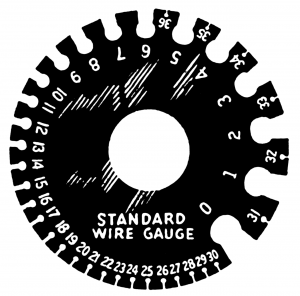Stereo and Speaker is reader-supported. When you buy through links on our site, we may earn an affiliate commission from Amazon at no added cost to you.
One of the most crucial things that people overlook when buying our vehicle’s audio system is the wires. Wires are a crucial part of our audio system because a good wire can affect the audio quality of your audio output and your audio system’s durability. So to simplify choosing the correct wire for your car audio system we have compiled a comprehensive Car Audio Speaker Wire Gauge Guide.
There are different types of wire gauges available in the market, and if you are confused about which wire gauge is right for your car audio speaker or sub, you are in the right place.
Let us now dive into the wire amp chart guide.
What does gauge mean in relation to wires?
Just like humans differ from one another, wires also vary in thickness and capabilities. Different sized wires have different capabilities and should be used for specific jobs.
The wire has been sorted into different categories according to its thickness. The different sizes are known as gauges.
A wire gauge is the measurement of a wire’s diameter. In this case, the smaller the gauge, the thicker the wire will be, so basically, the gauge is the outer layering of the wire. This determines the amount of electric current a wire can safely carry and its electrical resistance and weight.

Subwoofers and amplifiers usually use wires with lower gauges, and wires with higher gauges are used more for crossovers, speakers, and tweeters.
The most commonly used wiring system standard is the American Wire Gauge Standard, and it has been in use since 1857 and is still in use worldwide to regulate the capabilities and the thickness of a wire.
The British Standard Wire Gauge System (SWG) is also well-known internationally, but the AWG has become the standard of choice over the years, and it is the one preferred.
Every time you buy a wire, you have to check the AWG of the wire because most of the time, people sell you wires with the wrong gauges and gauge jackets. Please make sure you check that they are following the AWG standard.
Why is a wire gauge important?
The AWG is essential because it means you can be sure what size of speaker wire you are getting and its uses. It helps us to distinguish different types of cables and their usages. We can be sure what we need for a particular device, and we can get just with the help of a number.
Conductivity:
There are a variety of speaker cable types that you can choose from. Oxygen-Free Copper (OFC) is the best option.
The OFC cables have copper in them, which is a great conductor of electricity. You can be assured of high-quality audio in your car audio systems because OFC cables deliver maximum energy to speakers and amplifiers.
You have to be careful and avoid CAA wires as these wires are coated with copper and have aluminum in them, which cannot conduct electricity as copper does.
This cable works particularly well inside the engine bay, where it will be exposed to heat and damp. The small amount of tin in OFC cables helps reduce corrosion of the cable in the long run. It is a very durable cable as well.
Strand Count:
The strand count of a wire refers to the number of individual strands interwoven together. These strands are all woven together to make a single conductor or a wire.
One should always use a stranded wire over a solid wire, and the reasons are as follows:
Durability:
Wires with individual strands are more durable than solid wires. Thanks to their numerous different strands, you won’t experience a significant loss in power transmission if one strand breaks. Whereas a single wire in a substantial wire gets busted, the power handling can decrease significantly. The single cables also tend to break when exposed to constant vibration.
Flexibility:
If you use a wire with individual strands instead of a solid wire, you will find it is more flexible. This is very helpful because the wire can be curved and bent to your desire when installing it, as it can be twisted easily with your hand. Solid wires are tough to bend in any direction and can be challenging to install, and are more rigid to make connections.
These solid wires can be useful for home appliances as they will be kept in a fixed place for a long time. The most widely used speaker wire gauge for speakers is 18, 16, or 14, and they perform very well.
Which is the best gauge speaker wire for your subwoofer?
If you use the wrong gauge speaker wire for your subwoofer, it will surely dampen your subwoofer’s performance. It could cause humming and lead to a lengthy process of troubleshooting.
This is why it is crucial to use the correct gauge wire for your subwoofer. Subwoofers usually use lower gauge wire, and the most common speaker wire gauges for subs are 16, 14, and 12. They are dual conductor wires that carry positive and negative polarity, and they are the best wires to use for crisp and clear sound quality.
Sometimes, when you cannot find the right gauge wire, it is better to round up than to round down in size. Using a 16-gauge wire when you need a 14-gauge wire will result in poor performance from your sub.
Your money is essential, so do not use an excessively large gauge wire than the one you need. But a slightly bigger wire one will not do any harm to your subwoofer’s performance.
Here are some of our favorite and most used speaker wires:
| Material | Product | Product Link |
| Oxygen Free Copper (OFC) | Voltive 16/2 Plenum Speaker Wire | |
| Copper Clad Aluminum (CCA) | InstallGear 16 Gauge AWG 100ft Speaker Wire |
- 16AWG, 2 CONDUCTORS, WHITE JACKET, 100FT SPOOL. 16 gauge speaker cable, featuring 26 strand OFC conductors and fire-safety rated for plenum use. Built to exacting standards with zero compromises.
- OXYGEN-FREE COPPER. Oxygen-free copper (OFC) conductors result in less signal loss and are more durable than conductors made of copper-clad aluminum (CCA).
- CL3P RATED. Plenum (CL3P) fire safety rating for installation in walls, risers (between floors), and plenums in both residential and commercial applications. UL Listed.
- TIME SAVING FEATURES. Ripcord reduces installation time. Jacket is printed with UL information, re-order part number, and foot markers which indicate precisely how much wire has been used and how much is remaining.
- GENERAL PURPOSE WIRE. Suitable for any low voltage application that requires stranded 16 gauge wire with 2 conductors: speakers, LED lighting, security alarm systems, etc.
- 100-FEET (30.5m) [ RED/BLACK 16 GAUGE SPEAKER WIRE ] - The lower the gauge number, the thicker the wire. Thicker wire presents less resistance to current flow.
- COPPER CLAD ALUMINUM (CCA) - CCA wiring provides a good conductor for transmitting audio. This is the most economical option when choosing speaker wire.
- RUGGED PVC JACKET - Allows free, wide and seamless adjustment of the required physical properties of this wire such as flexibility, elasticity, and impact resistance.
- EASY POLARITY IDENTIFICATION - This two color jacket allows for easy polarity identification. Making a polarity mistake could be damaging to your audio equipment.
- SOFT TOUCH JACKET - The jacket on our cable is designed with the installer in mind. The flexibility of this jacket allows for easy routing and has a low memory.
How much wire do you need?
To determine how much speaker wire you will need a string or a measurement tape to measure from the amplifier location to each of your speaker locations. You can measure it and then go to the retailer and buy it from there but make sure always to buy a few extra feet as it will make it easy for you to connect it to your gear.
Everyday use and the know-how
If you are an average listener and a good system isn’t your top priority, it is not a problem for your day-to-day use. However, if you’re going to drive speakers at high power levels and want the best possible audio quality, you should go for the OFC cables or check your packaging to see if it is 100% pure copper wire.
In case you are going for CCA wires due to any such reason, then we suggest you move up one gauge in size to get better performance. CCA wires might be cheaper, but it is nowhere near copper wires, and I would suggest you not opt for CCA wires no matter the reason.
Frequently Asked Questions
Does speaker wire affect sound quality?
If we are talking about low-wattage systems, it doesn’t affect the performance or the sound quality. But the resistance that the speaker will offer to the current flowing through the cable and the distance it needs to travel are two crucial things to keep in mind.
A wire with a better core means more power can pass through and provide a cleaner and more crisp sound.
Is a lower gauge speaker wire better?
No, just because the wire’s gauge is lower, it does not mean it is better. It is better to use thicker wires over long distances, but the distance covered for a car’s audio system is relatively short.
A 16-gauge wire should work just fine for distances up to 100 ft. There is no assurance that a lower gauge speaker wire will offer you better audio sound.
How many watts can a stock speaker wire handle?
A stock speaker wire can handle up to 75W. This is sufficient for general use, but if you are looking for more wattage, you will need to replace your wire with a thicker gauge.
How do I identify a positive and a negative wire?
It is effortless and easy to identify a positive and a negative wire, but some people still tend to make mistakes; positive wires are always marked with something or have a different color as to the negative. Some examples are:
- Positive wires have a line or a series of lines on them.
- The insulation of one wire is red or different from the negative wire.
- Positive wires have symbols or wire gauges printed on them.
- A strip or a molded stripe is made in the positive wire’s insulation.
- The copper-colored wire is usually positive.
Does wire color matter?
Not necessarily, but using different wires within your electrical assembly is a good practice. It can help in the future and understand the purpose of each wire.
Many companies worldwide use standardized wire colors to denote hot wires, ground wires, and neutral wires; some might even color code within an electrical assembly.
Conclusion
As we know that sub-wire gauges are critical if we want to set up our audio system in our vehicles properly, it allows your gears to perform at their best. The right gauge is the right choice. Please make sure the product you are purchasing is what your equipment requires. And be sure to check if it is 100% copper or not and also to avoid CCA wires. Stranded wires over solid wires because many men are much stronger than one strong man.
If you found this article helpful, make sure to let us know in the comments. And also make sure to check out the best sub amp combos in 2021.
Amazon and the Amazon logo are trademarks of Amazon.com, Inc, or its affiliates.


